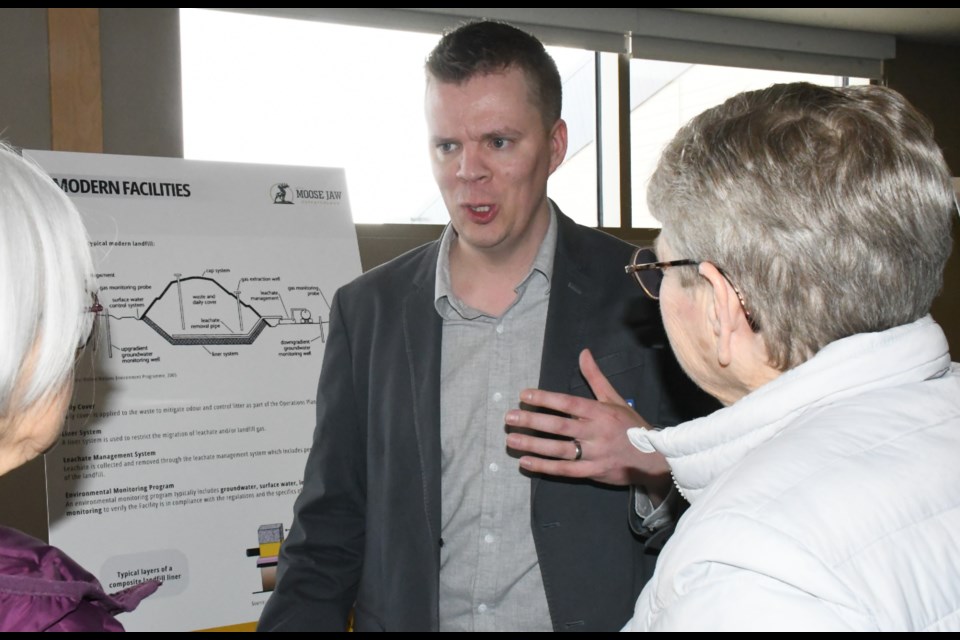Over 100 people attended city hall’s two-session open house about the proposed new landfill, which officials say is almost reminiscent of the public’s interest in the cast iron water main replacement program.
“(It’s a) great turnout. This is the most people I’ve seen for an open house like this by quite a stretch,” Bevan Harlton, operations director, said on Feb. 22 at the Events Centre, noting this was his third open house within the past year and the best attended.
“… I hope it’s a useful venue for people to voice their thoughts and concerns so we can hear them and write them down and try to understand and respond to those concerns as we can,” he continued. “That’s why (the open houses have) value.”
While some people are concerned about increased traffic, wetlands and other environmental effects, Harlton wanted people to understand what the venue would look like and what the city would do to handle garbage at a solid waste management venue.
“A point I haven’t gotten through to people is that the concerns of the ratepayers are also the concerns of the regulator,” he said, noting the Water Security Agency, Ministry of Highways and Ministry of Environment also want the city to address those worries.
The city has a regulatory responsibility to handle these issues if it wants the project to proceed, while it must acquire a permit to construct the venue to certain specifications and then acquire a permit to operate and follow specific standards, Harlton continued.
“… it’s not possible to assuage everyone’s concerns, but certainly, this forum is a necessary step and I hope it’s helpful for folks,” he added.
Some open house attendees expressed concern that it would take 20 years for newly planted trees to become an effective buffer around the site.
The city has not confirmed whether it would plant trees or transplant mature ones, and while it hasn’t moved past the conceptual design stage yet, Harlton said it won’t rely on one type of tree or bush to be a buffer. However, transplanting mature bushes and using seedlings might be a good combination.
“What that berm must do is block the wind as much as it can and block sightlines. So, it will have to be a combination of different things,” he stated, noting vehicles parked beside the venue won’t see the garbage because the berm will be two to three metres high.
City hall submitted a discretionary use application to the Rural Municipality of Moose Jaw in January to use the land as a new dump, with the rural council now determining whether to approve the submission. If it rejects the proposal, Harlton said the “potential” exists for the city to expropriate the land.
“I’m trying to make this one work, (so) we’ll have to see what our options are moving forward,” he said. “We haven’t put forward mechanisms to start expropriating things, but I have an obligation to manage this material, and if this one doesn’t work, we’ll have to move on to plan B.”
Asked what plan B was, Harlton added, “I couldn’t tell ya.”
Mark Parker, an engineer with consulting firm GHD Limited, said his firm helped select the site and used several technical criteria and other city-mandated standards to ensure the site was suitable.
One challenge the company faced was ensuring the venue was away from the municipal airport and 15 Wing Airbase because there are “hard constraints” dictating where such venues can go, he added, noting other constraints include nearby wetlands.
City hall wanted a new landfill within two kilometres of the community because a venue that was too far away would affect operational dollars, said Harlton. Meanwhile, he said officials have no plans to move either the bus barns or public works operations to the site.
This will be a modern waste management venue that is highly engineered to include liners, leachate catchments, appropriate stormwater management and opportunities for waste diversion and recycling, Parker said.
He added that addressing people’s concerns through engineering is what GHD does to ensure it is managing water properly and preventing land contamination.




